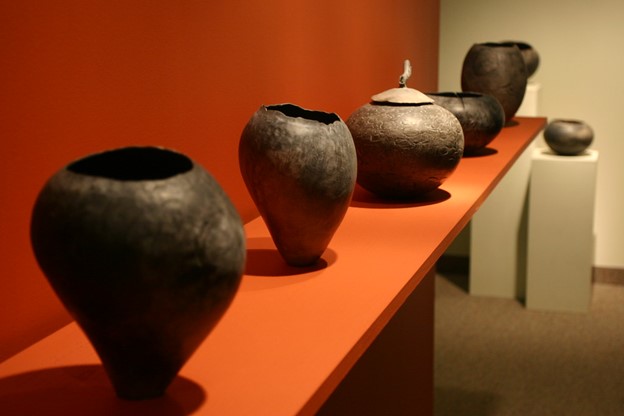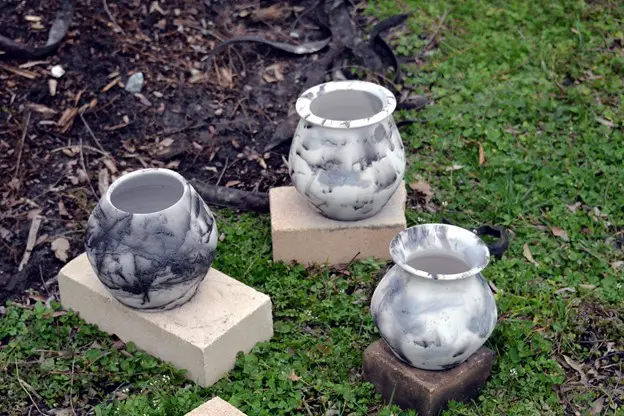As we unfold the unknown territories of pottery firing, let us work through a crucial chapter in the Obvara firing book. This type of firing is relatively unknown in the market, with less information for pottery enthusiasts. However, we aim to educate the artists, so here we explain the Obvara firing technique, the ingredients required, and the right way to perform it.
What is Obvara Pottery Firing?
The Obvara firing technique derives its origin story way back in the 19th and 20th-century eras. This Belarusian technique involves scalding the pottery finish in order to seal its porous surface. Alternatively, it is also popular by the name Baltic Raku firing. In this process, the bisque pottery piece is gradually heated up to approximately 1650 Fahrenheit. Next, the fired-up piece is dunked straight into the thick Obvara mixture for coating. Next, it is dunked right into the water for a rapid cooling process.
The finished pieces can range from near-black to off-white in color, with speckles all over the surface. This new firing technique is ideal for sealing out the porous surface of the clay. However, it might not be ideal for being used as food-serving pottery.
How to prepare your Obvara mixture perfectly?
In order to prepare your Obvara mixture in the right way, you would need the following ingredients:
- Warm Water- 2.6 Gallons
- Flour- 2.2 Pounds
- Sugar- 1 Tablespoon
- Yeast- 2 Packets
However, keep in mind that this isn’t an instant mixture. It must be allowed to ferment for a minimum of 3 days while you stir it every now and then to ensure the content doesn’t settle down in the bottom.
Now that we are done preparing the dipping mixture let us talk about the process.
Obvara Mixture: Complete Firing and Coating Process
For the Obvara firing process to work, the pottery pieces should be crafted only from clay designed to withstand instant thermal shock. This could either be a pottery item crafted from grog stoneware or a raku body.
Also, keep in mind that your pottery mush has a large opening to allow faster heat dissipation while preventing any possible explosion. As per your requirement, these pottery pieces’ surfaces could either be textured or smooth depending on the material being used.
Next, you need to bisque these pieces to a temperature ranging around 1800 to 1850 degrees Fahrenheit. To finish the firing process, you can make use of any kiln with easy access during the firing process. Make sure you refrain from performing this process indoors as it leaves a burnt toast smell all around and opening your kiln at this high temperature might lead to a disastrous fire hazard.

Next, fire your bisque pottery items to a temperature of around 1652 degrees Fahrenheit. Remove these fired items using a reliable set of metal tongs & immediately dip them into your Obvara mixture while swirling it continuously. This ensures that the mixture has evenly coated the entire surface. Your Obvara process won’t work if the temperature is too low, as it would only create a slime-like mess.
You might end up dropping the pottery item without the right tongs, and all your effort would be a waste. So, make sure you use a durable set of tongs designed to handle high temperatures while protecting your hands from heat. We would recommend that you consider the Comiart Clay Sculpture Dipping Tong to get the best results!
Make sure you don’t drop the item into the container as it might be hard to remove given the high temperature. After the coating is done, carefully remove your pottery piece & drain out the mixture to ensure the cover is even all around.
Next, dip this pottery item immediately into a large water container. Once again, you need to refrain from dropping it into the water container. Just swirl it around with the help of the tongs. After you have swirled it for a minute or two, set it aside to cool it down.
Now that we have established the ingredients and process needed for Obvara firing let us check out the maximum temperature and cone number that can be used for this firing technique.
| Cone Number | Temperature (Centigrade) | Temperature (Fahrenheit) |
| 022 | 600 | 1112 |
| 021 | 614 | 1137 |
| 020 | 635 | 1175 |
| 019 | 683 | 1261 |
| 018 | 717 | 1322 |
| 017 | 747 | 1376 |
| 016 | 792 | 1457 |
| 015 | 804 | 1479 |
| 014 | 838 | 1540 |
| 013 | 852 | 1565 |
| 012 | 884 | 1623 |
| 011 | 894 | 1641 |
| 010 | 900 | 1652 |
| 09 | 923 | 1693 |
Can Obvara firing be used with other techniques?
Through several experiments, it has been discovered that this ancient technique can be mixed with the Terra Sigillata technique prior to firing in order to obtain an interesting and beautiful crackle effect that shows up on the surface. Even with a textured surface backed by the horsehair decoration, one can obtain some exciting results.
Additional Pointers to Remember During Obvara Firing
This firing process’s trickiest segment is removing them immediately from the kiln and swirling them in the mixture & then directly into the water before the temperature cools down. Therefore, one must be patient and quick enough not to drop it.
Additionally, post the firing and swirling process, you can seal the clay pieces using beeswax in order to minimize the left-out porosity. Adding a bit of mix to the Obvara mixture can also bring out beautiful textures.
Given the fact that this process is smokeless in nature, it won’t leave you coughing or gasping for air. You don’t even have to glaze the product post the initial firing process. In case you do not like the final pattern, you can always refire the piece, and the old pattern will burn off. So, Obvara leaves you open for experimentation.
If you wish to get darker colors, you can allow the pot to stay in this mixture for a long to get that effect. As Obvara is a fast-firing process, even seconds longer can change the result you get. So, experiment wisely!
Conclusion
Trying out a new pottery firing technique can be very enticing for enthusiasts. However, it is just as important that you follow the precautions to avoid any accidents that might happen in artwork that involve fire.







